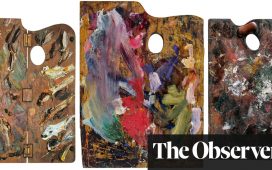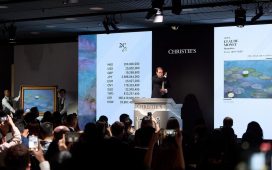Paula Rego hung her small collection of Goya prints in her bedroom, facing her bed. One in particular caught my eye in this attempt to set these two Iberian artists side by side. It’s Love and Death, from Goya’s series Los Caprichos. A woman who is wild and haggard with grief cradles the corpse of the man she loved: in doing so, she holds him up, willing him to stand like a living body. It reminds me of Rego’s disturbing masterpiece The Family, in which a woman holds up the doll-like form of her paralysed husband, her face ambiguous and musing.
The Goya print she owned is surely a source for this painting that autobiographically dissects Rego’s marriage to artist Victor Willing, who had MS. Looking at Goya’s Love and Death through Rego’s eyes, you feel the genuine connection between these artists. If only it were evident elsewhere, in a show that does a disastrous job of setting a modern master against a past one.
Trouble strikes almost immediately: Rego’s Nursery Rhymes, etchings and aquatints produced in the late 1980s, hang in alternation with Goya’s Los Disparates: a Goya, a Rego, a Goya … and so on round the room. I entered the room a Rego fan. I left with my faith badly shaken.
In Goya’s etchings, people stream from shadows into deeper shadows, taking form yet simultaneously disintegrating in a nightmarish cloud of hints and tremors out of which an agonised face stares, a body convulses. He etched these prints from 1815 to 1823, in the wake of the horrors of the Napoleonic Wars, at the same time as he was covering the walls of his home outside Madrid with his so-called Black Paintings. The prints share not only the paintings’ enigmatic content but their Stygian palette – made even darker by the etchings’ black ink.
Language can’t convey the indescribable truth of Goya. Sure, there are images you can cling to: men flying with feathery wings, a grinning giant, a woman being dragged off by a horse. But the way he depicts these things makes them infinitely stranger than they sound: every line, every shading has a delicate immateriality that makes you feel you are peering into a counterlife of dreams and night terrors in pictures that are more than 200 years old yet seem to be created by the ghostly figure of Goya right before your eyes.
Rego’s Nursery Rhymes look clunky beside them. They are too solid, too explicable. She gives old nursery rhymes a twist, but compared with Goya it seems laboured and superficial. Rego’s Hey Diddle Diddle depicts a cat playing a manic dance while a cow jumps over the moon. It hangs near Goya’s vision of a herd of cattle, their bodies weirdly intertwined, floating together in the dead night air. Rego’s image has a text, a context. Goya’s flying bovines can’t be explained away. They illustrate nothing, tell no story. A million art historians tracing a million “sources” will never explain the mind-boggling quiddity of his monstrous dream.
Rego, of course, is not doing the same thing as Goya at all: she is giving her idiosyncratic take on classic children’s verses. Yet the show not only treats her mildly subversive versions of Ride a Cock Horse or Little Miss Muffet as if they were the equals of Goya’s inimitable labyrinths, but also matches them visually with unbelievable crassness: Ride a Cock Horse is hung by Goya’s Punctual Folly, showing a woman standing on a horse on a tightrope; Baa Baa Black Sheep, in which a girl encounters a devilish ram, is next to Goya’s The Kidnapping Horse, showing a woman being carried off by a monstrous steed. And so on.
Baa Baa Black Sheep is one of the best Regos here, but it is just so much easier to interpret than the Goya: a young woman meets the mystery of desire. Goya’s equine rapture, by contrast, is not “saying” anything: it’s showing you a raw image that transcends its mythological sources, an unmediated unconscious vision that appals and delights.
after newsletter promotion
Rego just doesn’t seem, here, to plumb the same depths. And the exhibition doesn’t want her to. While the title theme of the “Uncanny” sounds hugely exciting, pitching Rego and Goya together as artists of the macabre, the wall texts want us to admire “the prominent role played by women in her Nursery Rhymes”. Fair enough. But if Rego is a rational political artist with a clear, positive “message”, what does she have in common with the shattering, irrational visions of Goya? She ends up being no more than Goya’s foil, pointing up the satanic majesty of his imagination. The show also includes some of her grotesque lifesize dolls but these too lose their bite after looking at Goya.
For the record, I can’t think of any other artist who would come out of a fight with Goya well. If the Prado were to put on a Francis Bacon show, in among its gallery of Goya’s Black Paintings, even Bacon would look pathetic.
Perhaps you had to be there – in Spain under Napoleonic rule in the early 1800s, witnessing dismembered bodies nailed to trees and frenzied protesters stabbing horsemen, seeing the sleep of reason produce monsters – to make art as terrifying and absolute as his. To be Goya, you need to go to the edge of the abyss.








